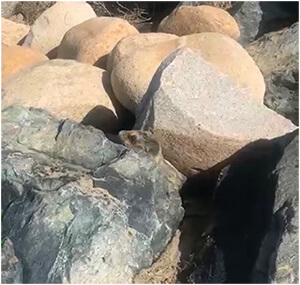A Tiny Tagged California Sea Lion Kicks Off the 2023 Rehabilitation Season

Yellow Tagged Sea Lion Hiding in the Rocks on Westward Beach
By Heather Henderson, Marine Program Manager
Each winter CWC prepares for the imminent arrival of young sea lion pups in need of help. In nature, California Sea Lions are born in June, with over half of the births occurring on June 15th. This is because sea lions have synchronized reproduction, where individual animals breed, birth, and wean on the same schedule. Ideally sea lion pups should stay with their mothers until April and wean when they are ten months old. While with their mothers, young pups practice fishing and learn important life survival skills.
Unfortunately, not all sea lion pups are able to stay with their mothers until April. Overfishing has led to a decline in available food for sea lions, which often causes mothers to venture farther and farther away looking for fish. This abandonment can force young pups to venture off looking for food, and sometimes they end up on the beaches of Malibu in need of help.
Our first patient of the season was fortunate to be discovered hiding in the rocks on Westward beach. The young female was reported to our Marine Mammal Response Team by a group of caring Malibu residents who were taking advantage of a long awaited warm and clear day. This winter, unseasonably cold days and heavy rains have left local beaches very quiet. Minimal human activity is a positive for healthy wildlife, however it is a drawback for distressed wildlife that may go unnoticed.
The little pup arrived in a malnourished state (weighed only 10.1kgs, which is about 50% of the healthy weight for her age), but with a feisty attitude. This was an encouraging sign that she may respond well to care and be able to return to the wild after her stay in rehabilitation. An interesting detail: this pup came in already outfitted with identifying yellow flipper tags. Most pups do not have identifying markers at rescue since they are too young to have gone through rehabilitation and release. These yellow flipper tags, and all colors other than orange, are population study tags. From the tags, we now know that she was born on San Miguel Island. At release the yellow tag on her right flipper will be replaced with an orange rehab tag. In California, rehabilitated seals and sea lions are tagged on the right flipper if a female and on the left flipper if a male.
After just a few weeks, yellow tag pup was eating whole fish and beginning to gain weight and strength. She is continuing to improve and is playing with the other pups in our care. California sea lions are a gregarious species and seek out companions. While in care, it is essential that sea lion pups are housed with other pups or older sea lions to promote competition while foraging and deter bonding with humans.
We anticipate that the yellow tag pup may meet a dozen more sea lion pups in the coming weeks. In 2017, which was the most recent severe wet winter in Los Angeles, we stayed busy with the stranding season from January through June. Will this rainy winter prove to be busy for our Marine Mammal Team? Cooler sea surface temperatures that accompany La Nina weather patterns can lead to schools of prey closer to the surface, which is beneficial for newly weaned animals. Yet rough seas and cool rainy conditions quickly exhaust young and weak pups. If you observe a marine mammal that is skinny, injured, small or seems out of place, please do not approach, or touch them – Report to our rescue team. #310 458 WILD. Together we can give them a second chance to thrive!
